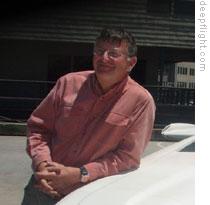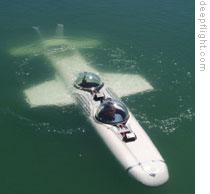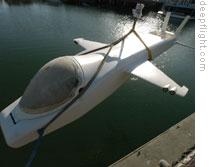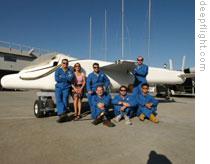VOA慢速英语 2008 1015b
搜索关注在线英语听力室公众号:tingroom,领取免费英语资料大礼包。
(单词翻译)
VOICE ONE:I'm Steve Ember.
VOICE TWO:
And I'm Shirley Griffith with EXPLORATIONS in VOA Special English. Two-thirds of the Earth is covered with water. But people have explored only a small part of the world's oceans. One person who means to change that is Graham Hawkes. He designs and builds submarines unlike any that have been made before.
(MUSIC)
VOICE ONE:
 |
| Graham Hawkes |
Graham Hawkes is an inventor, designer, explorer and visionary. His company, Hawkes Ocean Technologies, is based in Point Richmond, California, near San Francisco. In his workshop, he and three employees use computers to design submarines that use the newest technologies. They have completely changed the way people think about undersea vehicles.
Mister Hawkes has compared traditional submarines to balloons. Submarines are built to go up and down by making themselves heavier, or lighter1, than water. Movement is severely2 limited and chasing creatures in the ocean is not possible.
Operating traditional deep-sea submarines is also very costly3. There is one main reason for this. They require support ships of up to one hundred meters in length. The ship must be able to lift a submarine weighing thousands of kilograms off its deck and into the water in rough sea conditions. The need for a huge support ship drives the cost of deep-sea exploration to thousands and even hundreds of thousands of dollars a day.
VOICE TWO:
Remote Operated Vehicles are one answer to lowering the cost of deep-sea exploration. R.O.V.s are deep-sea robots. They do not need to protect humans against the crushing pressure of the deep-water environment. So these robots can be small and more easily moved from the deck of a smaller ship.
But robotic exploration of the ocean is not what interests Graham Hawkes. He urges the direct experience of human exploration of the ocean depths. To reach his dream, he knew he had to build a submarine that was smaller and smarter than traditional undersea vehicles, or submersibles.
VOICE ONE:
Graham Hawkes realized that he could greatly cut the cost of operating a submarine by making it smaller and lighter. To do this, he designed a completely different submersible. Traditional submarines sink. But Graham Hawkes' submarines are designed to be lighter than water. They will float to the surface it there is a problem.
Wings on the submarines permit them to "fly" through the water. But, unlike airplane wings, which create lift, the wings on Mister Hawkes' submarines force the vehicle down. In fact, the submarines must go forward in order to dive.
VOICE TWO:
 |
| Graham Hawkes tests the Deep Flight Super Falcon4 |
Graham Hawkes' most recent submarine design, the Deep Flight Super Falcon, looks like a fighter airplane. That is because it uses similar design elements. It holds two people who can look out into the ocean through two large, rounded windows, or domes6. Also, the submarine is fast enough to follow creatures in the sea. That was one of its design requirements.
The first Deep Flight Super Falcon already has an owner: California businessman Tom Perkins. Mister Perkins owns the world's biggest sailing boat, the Maltese Falcon, valued at one hundred eighty million dollars. But he is also an able diver interested in the sea. He wanted a vehicle that would provide underwater experiences that no one else has had. Graham Hawkes describes the submarine this way.
GRAHAM HAWKES: "The Super Falcon for Tom Perkins really isn't compromised. It is a beautiful, rounded, high-performance, you know, machine. If you want to know what it looks like, just think of a two-seater, underwater jet trainer. And that's pretty much it exactly."
VOICE ONE:
The Deep Flight Super Falcon is the world's first submersible built for "sub-sea flight" that can be produced in numbers. But it is costly. Its base price is about one million seven hundred thousand dollars. Fully7 equipped, it can be much more. Mister Hawkes is building a second Super Falcon for himself. He plans to use it to offer classes in sub-sea flight.
(MUSIC)
VOICE TWO:
Graham Hawkes has had a long working life building undersea vehicles. He was born in London in nineteen forty-seven. He studied mechanical engineering at the London Polytechnic8. After college, he began working with the Royal Navy on small submersibles that could be linked with larger submarines. Later he designed deep-sea diving suits and many undersea vehicles for the offshore9 oil industry. During his early work, he built about fifty submersible vehicles. He tested many of these inventions himself.
VOICE ONE:
But these projects never satisfied Graham Hawkes' desire to go further, faster and deeper. It took him over twenty years to reach the decision to go out on his own. Graham Hawkes realized that, to reach his goals, he had to make a huge change. It would be the same kind of technological10 jump that aviators11 made when they went from balloons to fixed-wing airplanes. In fact, Mister Hawkes calls the technology he developed "sub-sea flight" to set it apart from traditional submarine designs.
VOICE TWO:
The move away from designing traditional submersibles was not easy. The military, the oil industry and scientists all use traditional submarines. There were no buyers for Mister Hawkes' revolutionary new submersibles. Graham Hawkes says he does not know how he was able to make his business work. He got a lot of help from volunteers, and support from National Geographic12, Television New Zealand and the film company, IMAX.
It took ten years to design and develop Hawkes Ocean Technology's first submarine, Deep Flight One. It was launched in nineteen ninety-six. It has not been easy to continue operations. But it is not profit that drives Graham Hawkes to design submarines. We asked him where he found the reason, or inspiration, for his work.
GRAHAM HAWKES: "I think if it was anywhere, it was the early days of aviation itself. If you look back to those pioneers, it was all driven by passion. It wasn't driven by money. And I think we're in the same position here, really. The first twenty years it wasn't about making money at all. It was about spending it."
(MUSIC)
VOICE ONE:
 |
| The Deep Flight Challenger |
The Deep Flight Challenger is another major project developed by Hawkes Ocean Technologies. This micro-submarine was built for adventurer Steve Fossett. He had hoped to use it to dive to the deepest part of the ocean: the Challenger Deep in the Pacific Ocean's Mariana Trench13.
Sending a person more than ten thousand nine hundred meters under the sea presents huge engineering problems. The water pressure at this depth is one and one fourth metric tons for each square centimeter.
The last, and only, submarine to travel to the Challenger Deep was the United States Navy-operated Trieste in nineteen sixty. The Trieste was more than eighteen meters long and weighed more than fifty thousand kilograms. But the crew stayed in a small two-meter round room with only a small window. That was not how Steve Fossett wanted to visit the ocean's deepest place.
VOICE TWO:
 |
| Graham Hawkes and his team with the Deep Flight Challenger |
The Deep Flight Challenger dives using the same sub-sea flight technology invented by Graham Hawkes. It has a large rounded dome5 window that lets the pilot see forward, above and to the sides. The window is built out of a ceramic14 material to withstand the intense ocean pressure. The five-meter long body is built of carbon fiber15. A high-technology manufacturing method creates an extremely strong but lightweight material. Still, the room that holds the pilot is surrounded by a layer of carbon fiber more than ten centimeters thick. The whole submersible weighs about three thousand six hundred kilograms.
VOICE ONE:
Sadly, Steve Fossett never had the chance to test the Deep Flight Challenger. He disappeared on September third, two thousand seven, while flying a small airplane over the state of Nevada. His remains16 and the wreckage17 of his plane were finally found earlier this month. The submarine designed for him was only about four weeks from its first tests when he disappeared. Graham Hawkes owns the deep flight technology used to build the submersible. But the estate of Steve Fossett owns the Deep Flight Challenger. Mister Hawkes tells us that he will probably not be the one to use the submarine to reach the goal of the Challenger Deep.
The Deep Flight Challenger is now in one of Mister Hawkes' workshops: nobody knows what its future will be.
VOICE TWO:
Graham Hawkes reminds everyone he speaks with that a huge part of the Earth remains unexplored. He says the next great goal is not the moon, but the sea. Now, his sub-sea flight technology has changed the rules for ocean exploration. In the future, people may use small submersibles to explore and enjoy the deep ocean. If that happens, they will probably have Graham Hawkes to thank for it.
(MUSIC)
VOICE ONE:
This program was written and produced by Mario Ritter. I'm Steve Ember.
VOICE TWO:
And I'm Shirley Griffith. To see pictures of these submarines, visit our Web site, voaspecialenglish.com. Join us again next week for Explorations in VOA Special English.
 收听单词发音
收听单词发音 




